Mary Menniti’s efforts to preserve the wisdom of green-thumbed Italian immigrants living throughout Pittsburgh have nourished many of us with their reminder of the Italian art of living well and “eating good.” Her Italian Garden Project is now over 10 years old, and as many of the gardeners are growing older, sharing their stories and ways of life is more important than ever.
A Summer in the Italian Garden
A few summers ago, while lost in the throes of a research project for school, I found myself spending a significant amount of time in Italian gardens here in Pittsburgh. While I expected to get a decent grade for my hands-on work, I never anticipated what changes in me would come from connecting to these folks and their gardens. By way of that since-forgotten assignment, I was introduced to Mary Menniti, the founder of the Italian Garden Project.
I spent time with Mary and her friends in their gardens, all tucked away in the hills of Pittsburgh. What secrets did I learn from these green-thumbed nonni? How best to store freshly-picked beans and tomatoes. How to serve an entire family from one season’s small harvest. Their knowledge of how to live happily.
Mariano, now 92, snuck me his homemade limoncello (which was delicious), and shared stories of his childhood in Italy. Of course, because eating is more than agricultural research, we dined on cheeses and olives, and Mary’s secret family recipe for biscotti. I felt a connection to something that had long been gone. So focused on assignments and busy worrying about my future, I had forgotten about my past.
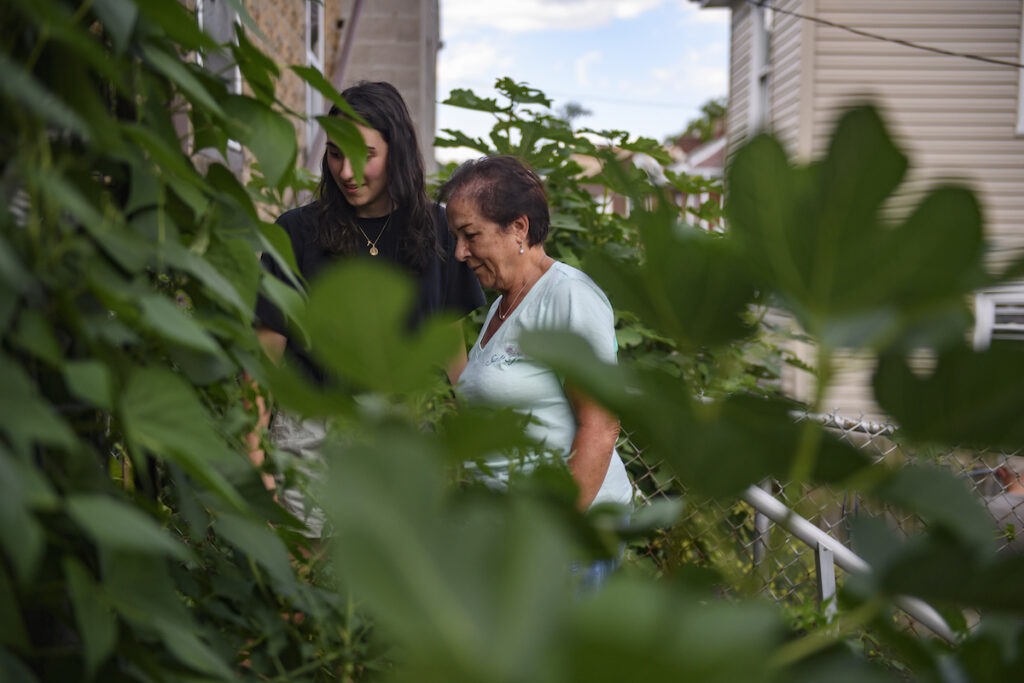
Looking Back
I was reminded of gardening with my grandmother in the summers as a school-aged child, helping her to pickle and can ripe peppers and tomatoes to keep beyond the growing season. I was reminded of the sense of connectedness that she had to the ground. How she just knew what to do with the earth. I remember her laughter. That is how I feel when I spend time with Mary and the gardens she knows so well.
Mary, too, got her start with gardening through her elders. Her grandfather settled in New Castle after immigrating from Italy in 1912. When Mary was born, he retired to spend his tending to a few acres filled with chickens, sheep, and in Mary’s eyes, “the most amazing garden … he got to spend his retirement days doing exactly what he wanted to be doing. It was so reminiscent of how he grew up before he left his family.”
When Mary would come home from school, she would spend the rest of her day in his presence, helping to harvest ripe vegetables. “As I picked up a hoe and hacked ineffectively at the ground, my grandfather would laugh and say ‘If there was a war, you people would starve.’ Those ‘you people,’ I knew, were my brothers and me and others who were the youth of the 1960s and ‘70s.
He was right. Compared to this hardworking Italian immigrant from the province of Caserta, my generation was a pampered lot,” said Mary. “We had none of the skills and knowledge to grow our own food and survive by our own hands.” Despite his teasing, Mary adored her grandfather. His heavy accent, and calloused hands. His unassuming manner and humble character. “I got to be with someone who shared a sense of homeness,” Mary says with a smile. “That love of gardens and animals and sense of peace influenced me a lot.”
Everything that Mary’s grandfather grew in their garden reflected his childhood in Italy, from unique tomato varieties to Swiss chard and dandelions. He loved his fig trees, to which Mary credits her personal interest in documenting them throughout America. “From his love of gardening grew my own.” Her grandmother would cook all that beautiful bounty into meals for their large family in her classic Italian kitchen.
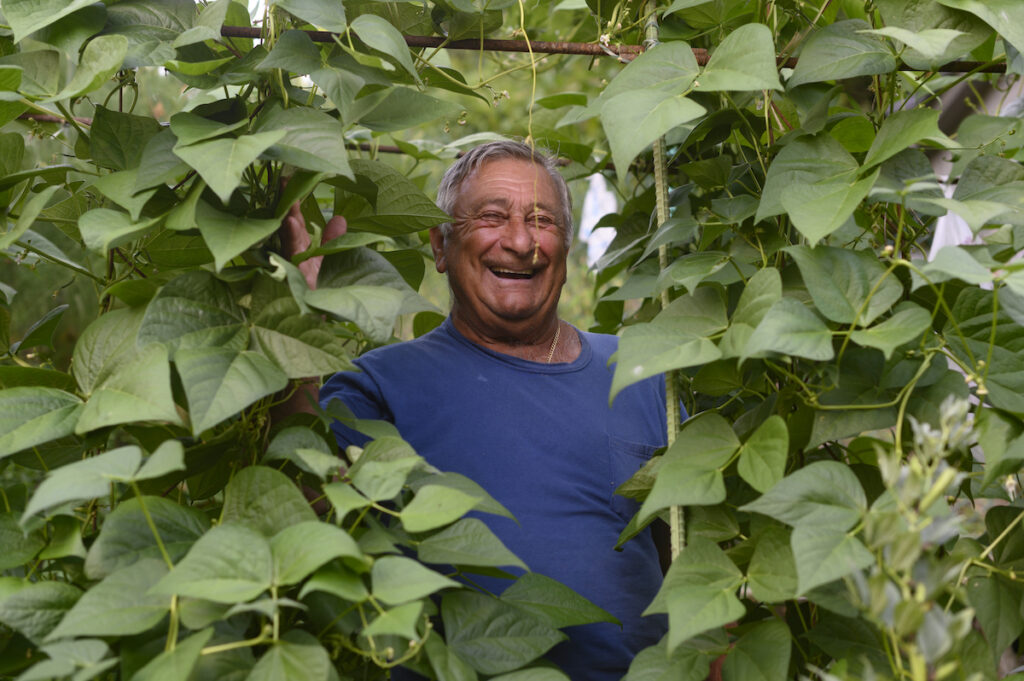
Fresh Roots
As soon as Mary had her first home, she planted a garden. When spending time in other people’s gardens, she found that her favorites were ones that reminded her of her childhood. “The ones with rows of tomatoes and peppers, pole beans and Swiss chard, garlic and fennel, and of course, fig trees.”
Mary has experienced two vastly different ways of being. Sharing the simple, yet full, life of gardening and homemaking with her grandfather in her childhood juxtaposed with the contemporary American life she experienced as she grew older. “I’ll bet my grandfather didn’t know he was participating in intergenerational learning when he scolded me in the garden. Today I see what is missing. That’s a big focus of my work. Focusing on a way of life.” A life practicing the connection to food, family, and the Earth. To Mary, there is a sense of well-being and contentment that is lost without these three practices. “What is horticultural therapy other than what Italian gardeners do every day where they tend their gardens, strengthening their bodies and souls.”
Branching Out
Since that initial summer, Mary has connected me to so many Italian immigrants and their grandchildren, including Marisa. Marisa grew up in her grandmother’s garden, who is now too sick to tend to it herself. Able to speak Italian, Marisa helped me gather stories of the gardeners she grew up with. Marisa explained to me that she has a lot to learn, too, especially as her family grows older. She sees the act of Italian gardening a way to stay connected to her heritage. Marisa and I are the same age, and it was fascinating to see someone with the same generational desire for continuing education and tradition.
Marisa and I spent an evening gathering stories in the Morningside neighborhood in the heat of July. The gardens were practically bursting with produce. Walking with Marisa, she pointed out that you can tell which ones are younger gardeners and which ones are Italian. “There’s something about the soil in Morningside,” she said with a soft smile on her face. I knew this day was important to her, just as it was to me.
As I walked into Marisa’s Great-Aunt Lisa’s garden, I was welcomed by sprouting eggplant, three kinds of basil, and crawling bean stalks. I sat with them on that warm summer evening, under the shade of overhanging grape vines, listening to stories told in a garden.
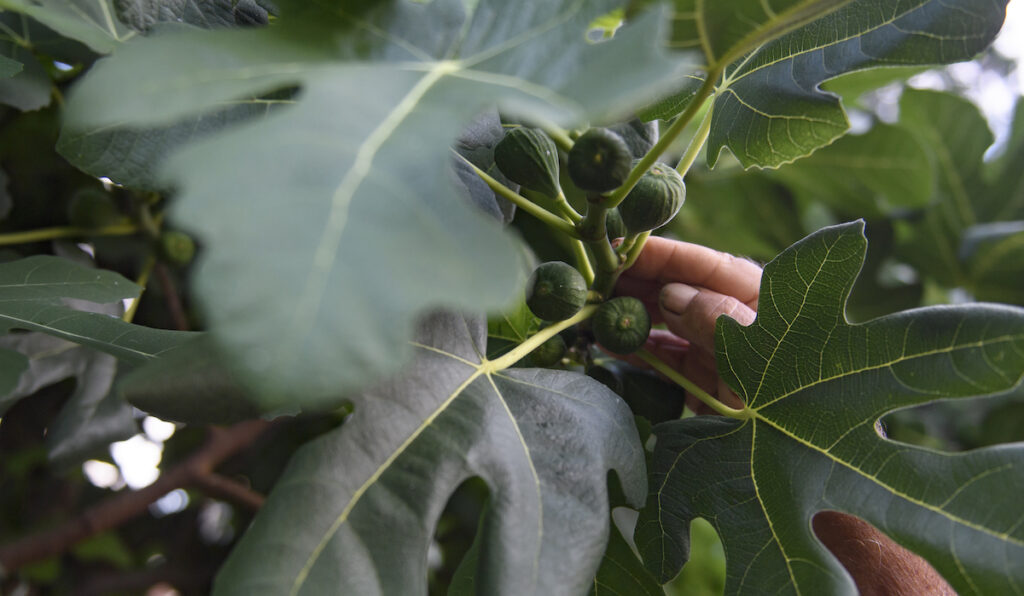
Rough Hands
To Lisa, prior to coming to the States in 1966, this was a way of life. “We had a big farm. We worked hard.” She was a wheat farmer as a child, harvesting it all by hand. “Everything is different. It’s not like before, you know. Before we used to work hard for everything with hands. Now, it’s different.” She kept it up when she moved to Pittsburgh.
“Dominic used to have a big garden,” Lisa said of her late husband, whom she moved with from Italy. “He would work all day, and then come here and work on his garden all night.” Dominic would preserve tomatoes and can sauce. “We would roast them. Put them in a jar.” They use these canned goods all throughout the year, for celebrations including San Rocco in August and La Vigilia in December, feeding upwards of 30 friends and family. “We had many, many, many feasts here at that table,” Lisa says of the freshly painted red picnic table we were sitting on together, which she and Dominic built when they first moved in.
She still keeps up the traditions she and Dominic did together, just as she paints the table every year, in preparation of the meals that will be gathered around it. “We make soppressata every year. Still!” Marisa, too, takes part in this yearly tradition, saying, “Yeah, it’s in January. It’s fun!” “Every year, we make 120 pounds,” says Lisa. They would go to the Strip District to get meat from their butcher. “We make the sausage downstairs and hang it in our basement. It’s a lot of work, but we get together with the family. It’s fun.”
When asked if Lisa felt Dominic when she gardened, she said, “Of course.” As happy as she is to keep up the traditions they shared, Lisa also told me that she “missed him in the garden.” She said, not meeting my eyes, “I have so many memories that it makes me upset. He was young.” Still, the garden helps her to remember Dominic despite the heartache. “But I enjoy it. I tell you though, I can’t do much now. But I like to keep doing it because of my husband. To fix the land like we did. Now he’s with God. He works over there.” Marisa also continues her great-aunt’s traditions, saying, “I’m learning. They have such good soil because they’ve been doing this for so long. I’d like to have a garden like this someday.”
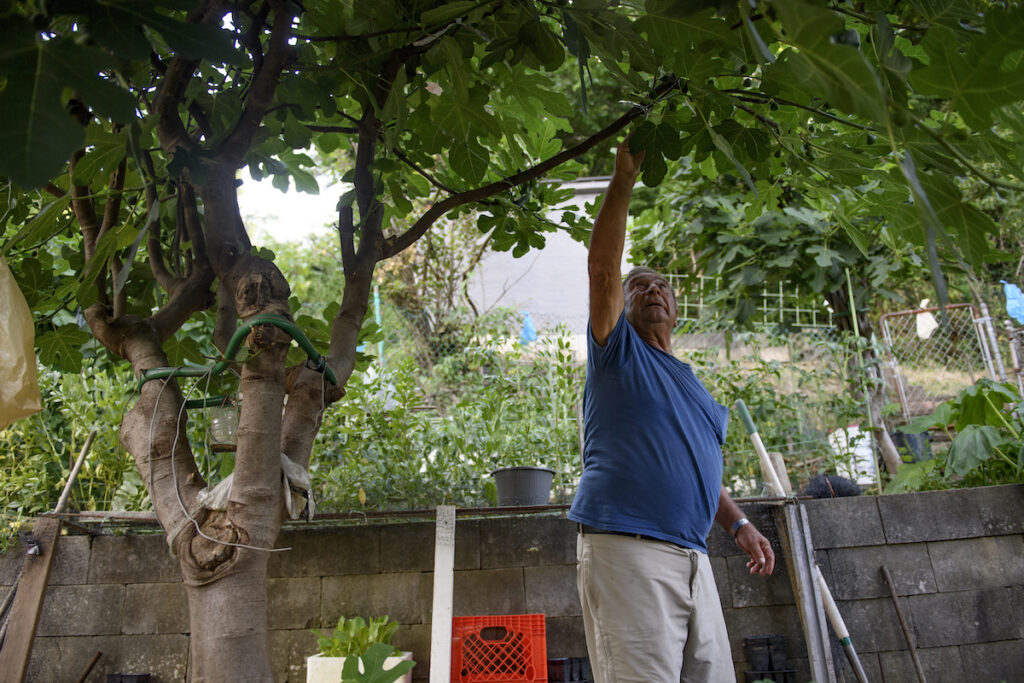
A Small Piece of Home
Later that night, we visited Pietro Curigliano’s garden, tucked within three tall brick walls, which he built himself years ago. It was filled to the brim with Roma beans, peppers, tomatoes, and, of course, fig trees. After five decades of working with fig trees in unforgiving Western PA weather, Pietro has become an expert. A revered fruit to Italian Americans, the fig adapts and thrives in a land not its own, much like the initial immigrants who grew them. Many Italian immigrants even carried small fig trees over to the States with them. Growing a fig tree when they arrived in the US was a way to have a small piece of home in the unknown. He excitedly showed us how he grafted two different kinds of fig trees together, and how he was working keeping birds away from eating his bounty.
Because of the harsh winters, he wraps them in tarps to keep them warm. There was only one year, Pietro told me, that he was unable to keep a fig tree alive. It was winter and he had broken his leg. “No one else could wrap it for me.” Pietro gave me two shoots from the trunk of the fig tree so that I could grow them at home myself and continue the legacy.
Deeping the Roots
The Italian Garden Project began 10 years ago, and it’s still growing. “2011 was the start of the project, but I began doing tours in 2009. They became extremely popular and each was filled to capacity.” Mary found that, just like me, other people love being in these gardens, too. Helping her with a tour in 2021, I saw the tour-goers speak with the gardeners and be amazed at their knowledge, at how naturally gardening has come to them. In return, the gardeners are amazed that there is such newfound interest in something that they have done their entire lives.
What started as a way to share gardening tips from long-time Italian gardeners through tours has grown into much more. “All these ideas for me came together: sustainability, family, seed- saving.” The gardens shared by the Italians who have settled in Pittsburgh have become increasingly relevant for people as they’re starting to recognize all the different things that come out of the Italian garden as parts of their lives.
“People are understanding the project more. They see this way of life and want it for themselves.” Italian gardeners have been eco-friendly since they first arrived in Pittsburgh. Rain barrels, composting, seed saving–these forms of conservation have always been an act of continuation despite their existing circumstances. The current emphasis on eating locally and with the seasons is an inherent part of these backyard gardens, including their efficient space. Tucked in small city lots, these Italian gardens can often produce enough to feed large families. They serve as a glimpse into the past that can lead into a brighter, more sustainable future.
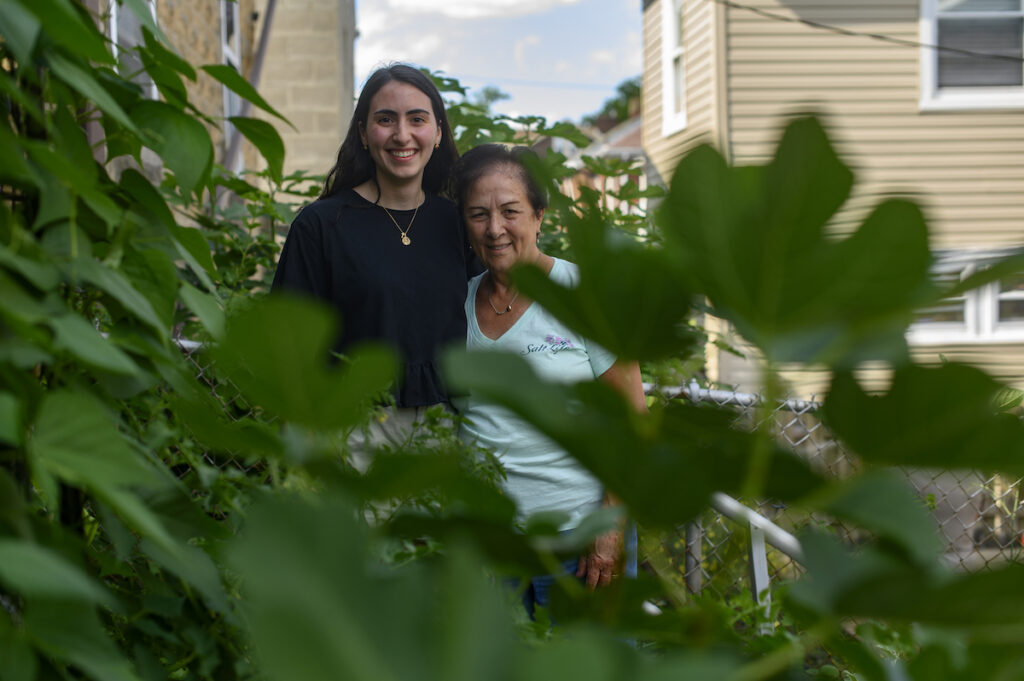
Contentment and Connection
As said by Mary, “People see this way of life and when they do, it almost makes them see what is missing from their daily lives. This connection to the Earth. To food, to tradition, and family, and people… So much of what is missing from the contemporary ways of life I know. These folks are role models for contentment and connection, and that’s really become the focus of the project as it has grown. It’s moved from trying to capture the gardening techniques and skills and knowledge that they have, to looking at the way of life as a whole. What it is about them that they have, that is missing from where daily life is going for most of us.”
I will remember my time in the garden with Mary and her friends with great appreciation, and the lessons of life that they have taught me. I’m still tending to that fig tree in hopes that it will grow and continue the legacy. There is much to learn if we are willing to listen, look, and remember.
Story by Lindsay Anne Herring / Photography by Jeff Swensen
Subscribe to TABLE Magazine’s print edition.

